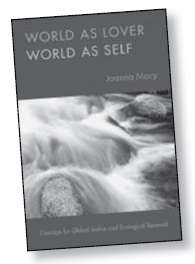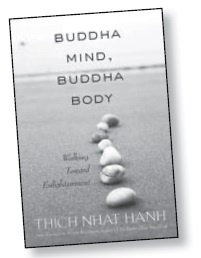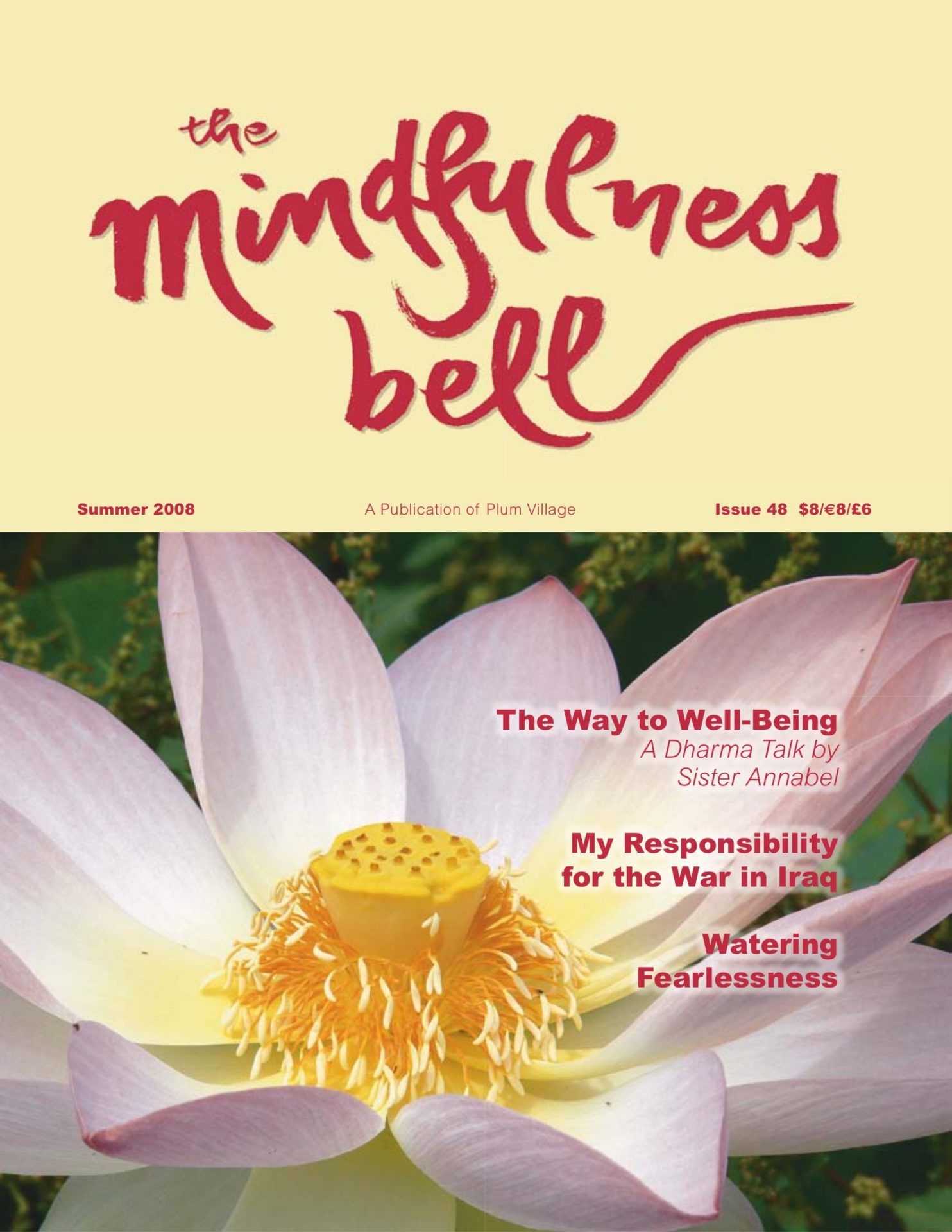
World As Lover, World As Self Courage for Global Justice and Ecological Renewal
By Joanna Macy
Revised edition Parallax Press, 2007 Paperback, 202 pages
Reviewed by Emily Whittle
Every once in a while a book falls into my lap that I want to purchase by the case and give away at busy street corners or drop from airplanes like packages of medicine.

World As Lover, World As Self Courage for Global Justice and Ecological Renewal
By Joanna Macy
Revised edition Parallax Press, 2007 Paperback, 202 pages
Reviewed by Emily Whittle
Every once in a while a book falls into my lap that I want to purchase by the case and give away at busy street corners or drop from airplanes like packages of medicine. World As Lover, World As Self by Joanna Macy is one of those books.
This is how Macy describes her book: “Carl Jung said that at the core of each life’s journey is one question we are born to pursue. The one question threading through my life here on this beautiful Earth is about how to be fully present to my world — present enough to rejoice and be useful — while we as a species are progressively destroying it. This book is my attempt to answer this preoccupation, as well as insight into the relief and guidance I have found in the teachings of the Buddha.”
Joanna Macy looks unblinking at the feeling of despair over the rapid extinction of species and the unprecedented plundering of our planet’s lands and waters. Giving voice to the pain of being alive in a special time when human beings have lost the certainty of the continuity of our species is an act of courage and of compassion. Her words brought me to tears, but they were tears of relief — the relief of honesty and clear naming.
Once named and honored, she proceeds to outline a path to heal our grief by first mining the past for wisdom that can help us, finding inspiration in the Buddha’s teaching of interdependent co-arising. This teaching “first shows us how profoundly we’re entangled in the web of life, thus relieving us of our human arrogance and loneliness. Second, it frees us from having to have it all figured out ahead of time, for the solutions arise as we walk the path and meet each other on the road. And lastly, it reveals our distinctiveness as humans: our capacity to choose.”
Ahhh! Already, I feel lighter.
Moving on to the present, she shares practical exercises to cultivate our gratitude, a sure antidote to despair. The Mohawk Thanksgiving Prayer gives me goose bumps and draws more tears. Reading it at sangha, I hear scattered sniffling and know a nerve has been touched.
She addresses the problems of apathy, burnout, and overwhelm that plague social activists, offering additional practical strategies for collective strengthening and awakening. Her suggestions provide a scaffold that can be creatively adapted to groups of many persuasions and focus.
In the final section, Macy addresses the future, challenging us to alter our sense of time through a powerful guided meditation, telescoping our life as Gaia into twenty-four hours. Seen in this context, our human history begins at one second to midnight. Then, rendering that final second into another twenty-four-hour day, the Buddha and Jesus arrive at six seconds to midnight; our industrial age bursting on the scene only in the last microseconds. But what swift changes those microseconds bring!
If the threat of our annihilation is the catalyst to our birthing as compassionate guardians of the Earth’s future, then even toxic nuclear waste can be viewed as a great gift. We can wake up. Books like this can be a valuable guide on the path of transformation.

Buddha Mind, Buddha Body Walking Toward Enlightenment
by Thich Nhat Hanh
Parallax Press, Berkeley, 2007 Softcover, 146 pages
Reviewed by Judith Toy
I am reading this book in the second month after the sudden passing of our thirty-six-year-old son, Jesse. I chose it because the back cover reads: “In... this follow-up to his classic book, Understanding Our Mind, Thich Nhat Hanh shows us how we can instill the habit of happiness in our consciousness.” I want my happiness back. I am reading it because, just as in the days when I first fell into the arms of Zen, I am desperate.
Back then, my sister-in-law and her two sons, my teenage nephews, had been murdered. Now our son is dead of a heroin overdose. The rhythm of Thay’s syntax in this book calms me. And his incredible clarity, as always, brightens my mind.
One of Thich Nhat Hanh’s great gifts to the world is a group method of outdoor walking meditation which he adapted from Shakyamuni Buddha’s first alms rounds. In Buddha Mind, Buddha Body, which would serve well as a primer for new students, Thay weaves in and out of walking meditation. “You can take a step and touch the earth in such a way that you establish yourself in the present moment, and you will arrive in the here and now. You don’t need to make any effort at all.” A good place to begin.
To this practice, he adds the basics of Buddhist psychology and the way to happiness through the Six Paramitas, which he supplements with a lucid explanation of the importance of Finding Wise Friends and the Four Elements of Love, the ground of our Bodhisattva path. Walking Meditation, Touching the Earth, and Total Relaxation are exercises offered by Thay so we can make manifest the words of this wisdom book, which includes the Verses on the Characteristics of the Eight Consciousnesses in both Chinese and English in Appendix I, and a Sanskrit key in Appendix II.
Buddha Mind, Buddha Body, is comprehensive. Thay tells how our minds work and how our feet work, and he shows us how we can use both body and mind to walk into the realm of happiness and reclaim our sovereignty, our free will. He shows us once again that happiness and freedom are not an individual matter. We will be liberated only when we can inter-be with all forms of life.
Yet this is only speculation until I can put into practice what our teacher so clearly articulates here through poems, stories, sutras, and scientific studies. So I put down the book and head for the mountain wilderness to walk with my late sister-in-law and my two nephews and our son, Jesse. “Jesse,” I say, “walk with me.” I call to Dougie, Danny, Louise. “Please walk with me.” I follow my breathing. With my boot soles, I kiss the red earth where Cherokee once roamed.
They are with me, too. And the mica strewn on every path in southern Appalachia — like glitter on the clay-red soil and decomposing leaves — shines as tiny mirrors, the net of Indra reflecting all Buddhas everywhere, each a window to the cosmos.
I am thinking of my Sangha friend Susan when on the path I spy a heart-shaped rock. Susan collects these! I pick it up and hold it in my palm. Its temperature is cold, but I know that, like my heart, if I continue to hold it, its original warmth will return. Suddenly I notice I feel happy, even in my sorrow.

